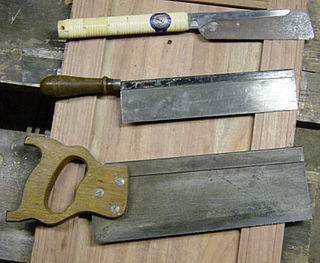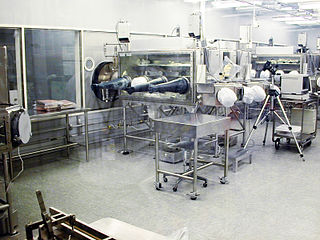Infusoria is a word used to describe various freshwater microorganisms, including ciliates, copepods, euglenoids, planktonic crustaceans, protozoa, unicellular algae and small invertebrates. Some authors have used the term as a synonym for Ciliophora. In modern, formal classifications, the term is considered obsolete; the microorganisms previously and colloquially referred to as Infusoria are mostly assigned to the kingdom Protista.

A microorganism, or microbe, is an organism of microscopic size, which may exist in its single-celled form or as a colony of cells.

Microbotics is the field of miniature robotics, in particular mobile robots with characteristic dimensions less than 1 mm. The term can also be used for robots capable of handling micrometer size components.

A cleanroom or clean room is an engineered space, which maintains a very low concentration of airborne particulates. It is well isolated, well-controlled from contamination, and actively cleansed. Such rooms are commonly needed for scientific research, and in industrial production for all nanoscale processes, such as semiconductor manufacturing. A cleanroom is designed to keep everything from dust, to airborne organisms, or vaporised particles, away from it, and so from whatever material is being handled inside it.

Sterilization refers to any process that removes, kills, or deactivates all forms of life and other biological agents present in or on a specific surface, object, or fluid. Sterilization can be achieved through various means, including heat, chemicals, irradiation, high pressure, and filtration. Sterilization is distinct from disinfection, sanitization, and pasteurization, in that those methods reduce rather than eliminate all forms of life and biological agents present. After sterilization, an object is referred to as being sterile or aseptic.

A nanobe is a tiny filamental structure first found in some rocks and sediments. Some scientists hypothesize that nanobes are the smallest form of life, 1/ 10 the size of the smallest known bacteria.

A backsaw is any hand saw which has a stiffening rib on the edge opposite the cutting edge, enabling better control and more precise cutting than with other types of saws. Backsaws are normally used in woodworking for precise work, such as cutting dovetails, mitres, or tenons in cabinetry and joinery. Because of the stiffening rib, backsaws are limited in the depth to which they can cut. Backsaws usually have relatively closely spaced teeth, often with little or no set.

Planetary protection is a guiding principle in the design of an interplanetary mission, aiming to prevent biological contamination of both the target celestial body and the Earth in the case of sample-return missions. Planetary protection reflects both the unknown nature of the space environment and the desire of the scientific community to preserve the pristine nature of celestial bodies until they can be studied in detail.

A chemostat is a bioreactor to which fresh medium is continuously added, while culture liquid containing left over nutrients, metabolic end products and microorganisms is continuously removed at the same rate to keep the culture volume constant. By changing the rate with which medium is added to the bioreactor the specific growth rate of the microorganism can be easily controlled within limits.
The pore space of soil contains the liquid and gas phases of soil, i.e., everything but the solid phase that contains mainly minerals of varying sizes as well as organic compounds.
Marinobacter hydrocarbonoclasticus is a species of bacteria found in sea water which are able to degrade hydrocarbons. The cells are rod-shaped and motile by means of a single polar flagellum.

The olive colobus monkey, also known as the green colobus or Van Beneden's colobus, is a species of primate in the family Cercopithecidae. Its English name refers to its dull olive upperparts. It is the smallest example of all colobine monkeys and is rarely observed in its natural habitat because of its cryptic coloration and secretive nature. It is found in the rain forests of West Africa, ranging from southern Sierra Leone to Nigeria. The IUCN Red List classifies the olive colobus as vulnerable, with the cause of its decline attributed to habitat loss and hunting. Though much of the land within the range of the olive colobus has been affected by human activities, it retains its ability to thrive in small degraded forest fragments.

Microbiology is the scientific study of microorganisms, those being of unicellular (single-celled), multicellular, or acellular. Microbiology encompasses numerous sub-disciplines including virology, bacteriology, protistology, mycology, immunology, and parasitology.

Blood Falls is an outflow of an iron oxide–tainted plume of saltwater, flowing from the tongue of Taylor Glacier onto the ice-covered surface of West Lake Bonney in the Taylor Valley of the McMurdo Dry Valleys in Victoria Land, East Antarctica.
Microbial biogeography is a subset of biogeography, a field that concerns the distribution of organisms across space and time. Although biogeography traditionally focused on plants and larger animals, recent studies have broadened this field to include distribution patterns of microorganisms. This extension of biogeography to smaller scales—known as "microbial biogeography"—is enabled by ongoing advances in genetic technologies.
Marinobacter adhaerens is a Gram-negative, rod-shaped and motile bactebacterium from the genus of Marinobacter which has been isolated from marine aggregates from the Wadden Sea in Germany.
Marinobacter maritimus is a Gram-negative, psychrotolerant and motile bacterium from the genus of Marinobacter which has been isolated from sea water near the Kerguelen islands.
Marinobacter psychrophilus is a Gram-negative, rod-shaped, psychrophilic and motile bacterium from the genus of Marinobacter which has been isolated from sea-ice of the Canadian Basin.
Marinobacter nanhaiticus is a Gram-negative, facultatively anaerobic and slightly halophilic bacterium from the genus of Marinobacter which has been isolated from sediments from the South China Sea. Marinobacter nanhaiticus has the ability to degrade polycyclic aromatic hydrocarbons.

The curation of extraterrestrial samples (astromaterials) obtained by sample-return missions takes place at facilities specially designed to preserve both the sample integrity and protect the Earth. Astromaterials are classified as either non-restricted or restricted, depending on the nature of the Solar System body. Non-restricted samples include the Moon, asteroids, comets, solar particles and space dust. Restricted bodies include planets or moons suspected to have either past or present habitable environments to microscopic life, and therefore must be treated as extremely biohazardous.











